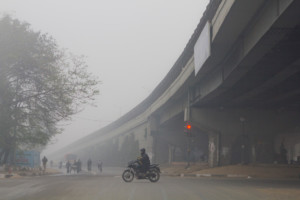Delhi-NCR, Mumbai, Bengaluru, Kolkata, Chennai, and Hyderabad among the list

Delhi has been recording dangerous levels of air pollution.
New Delhi, July 4 | As Indian metro cities continue to battle alarming pollution levels, Greenpeace’s analysis of NO2 satellite data re-asserts that transport and industrial clusters are giving rise to the country’s worst Nitrogen Oxide (NOx) hotspots.
In the first sixteen months of Tropospheric Monitoring Instrument (TROPOMI) NO2 satellite data from February 2018 through May 2019, cities such as Delhi-NCR, Bengaluru, Kolkata, Chennai and Hyderabad which have high vehicular populations and diesel/oil consumption are the most polluting hotspots. However coal consumption and industrial clusters like Sonbhadra-Singrauli in Madhya Pradesh & Uttar Pradesh, Korba in Chattisgarh, Talcher in Odisha, Chandrapur in Maharashtra, Mundra in Gujarat and Durgapur in West Bengal were equally polluting when it comes to NOx emissions.
“Over the past few years, several studies have identified PM2.5, NOx and O3 pollutants having significant impact on human health. These are particularly dangerous air pollutants, causing respiratory illnesses and lung damage with acute exposure, and increasing the risk of chronic diseases such as heart attacks and lung cancer etc. with long-term exposure,” said Pujarini Sen, Senior Campaigner, Greenpeace India.
NO2 is a dangerous pollutant in itself and also contributes to the formation of ozone and PM2.5, two of the most dangerous air pollutants. It is estimated that air pollution (ambient PM2.5 household and ozone air pollution collectively) caused 3.4 million deaths worldwide in 2017 and over 1.2 million only in India. PM2.5 alone resulted in more than 6.7 lakh deaths in India in 2017.
IIT Kanpur report in 2015 mentioned that, “90% reduction in NOx from power plants in a radius of 300 kms from Delhi can reduce nitrates by 45% which will effectively reduce PM10 and PM2.5 concentrations in Delhi by about 37 µg/m3 and 23 µg/m3 respectively.” Such a reduction, if achieved, would be very significant as the WHO’s annual guidance for PM2.5 is 10 µg/m3 and Indian standard is 40 µg/m3.
Earlier this year, Air Pollution Global Cities Ranking Report released by Greenpeace found that 15 of the 20 most polluted cities in the world are located in India, highlighting the country’s air pollution crisis. In January 2019, Airpocalypse III report by Greenpeace India, found 241 cities violating National Ambient Air Quality Standards (NAAQS).
Sen demanded strict and urgent action by the Government and polluting industries. “All sources of Nox, i.e., transport, industries and power generation should be tackled keeping in view the health emergency India faces today. Source apportionment studies must be used to lay down sectoral targets, and the list of ‘non-attainment cities’ needs to be updated & city-wise target in the National Clean Air Plan. Emission standard deadlines for coal power plants and industries must be strictly adhered to, even as the industrial and electricity sectors transition to cleaner alternatives for power generation. Every delay is literally costing lives!”
For more information contact:
Pujarini Sen, +918586016050, pujarini.sen@
Avinash Kumar, 8882153664, avinash.kumar@
Rohin Kumar, +919013971997, rokumar@

Discussion
Large scale water and pollution in my city and gpcb is completely fail to stop this harmful both pollution
Any increase in Pm 2.5 in this pandemic of covid19 will give island size vehicles for the virus and we all know about pm2.5's easy entry into the resp tract.how many pandemics of virulent pathogens will it take for the world to realize that zero emissions is imperative .I am sure the flora and the rest of the fauna would wish us extinct if they could